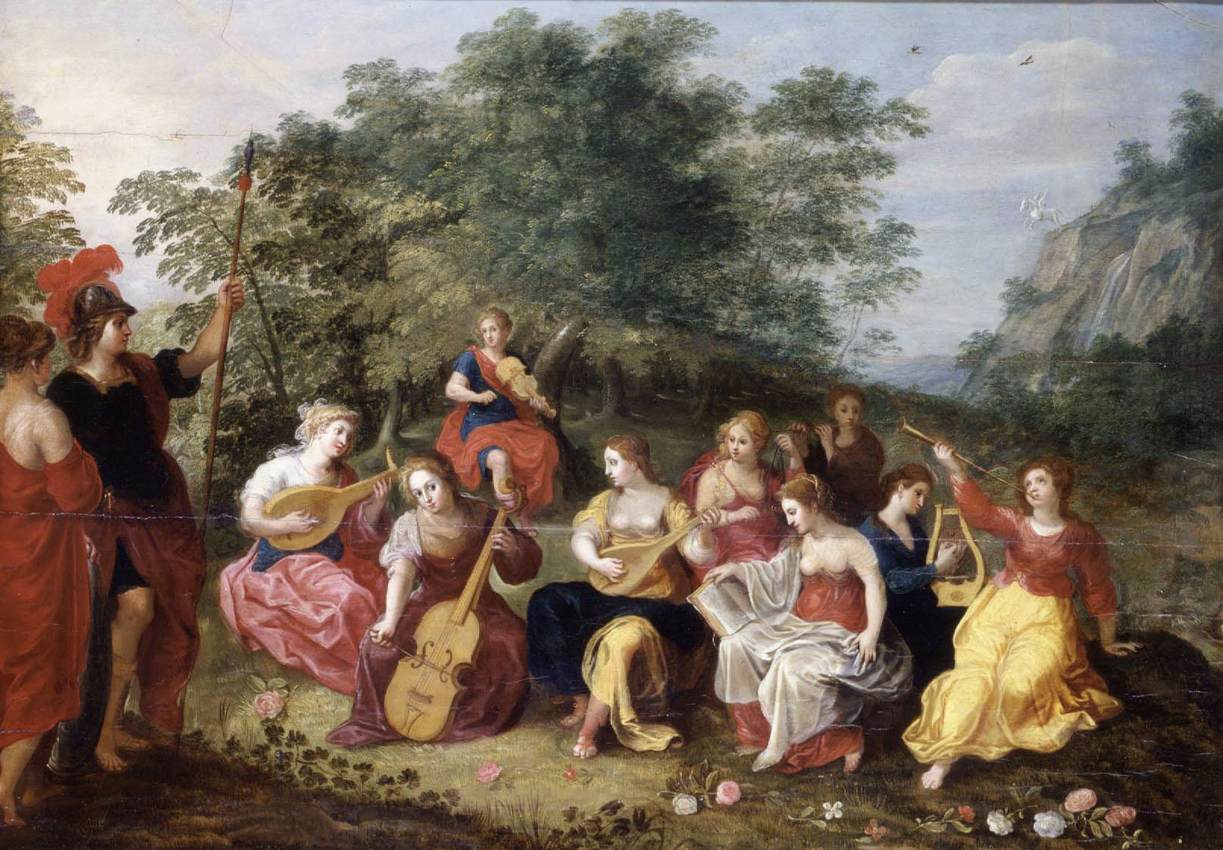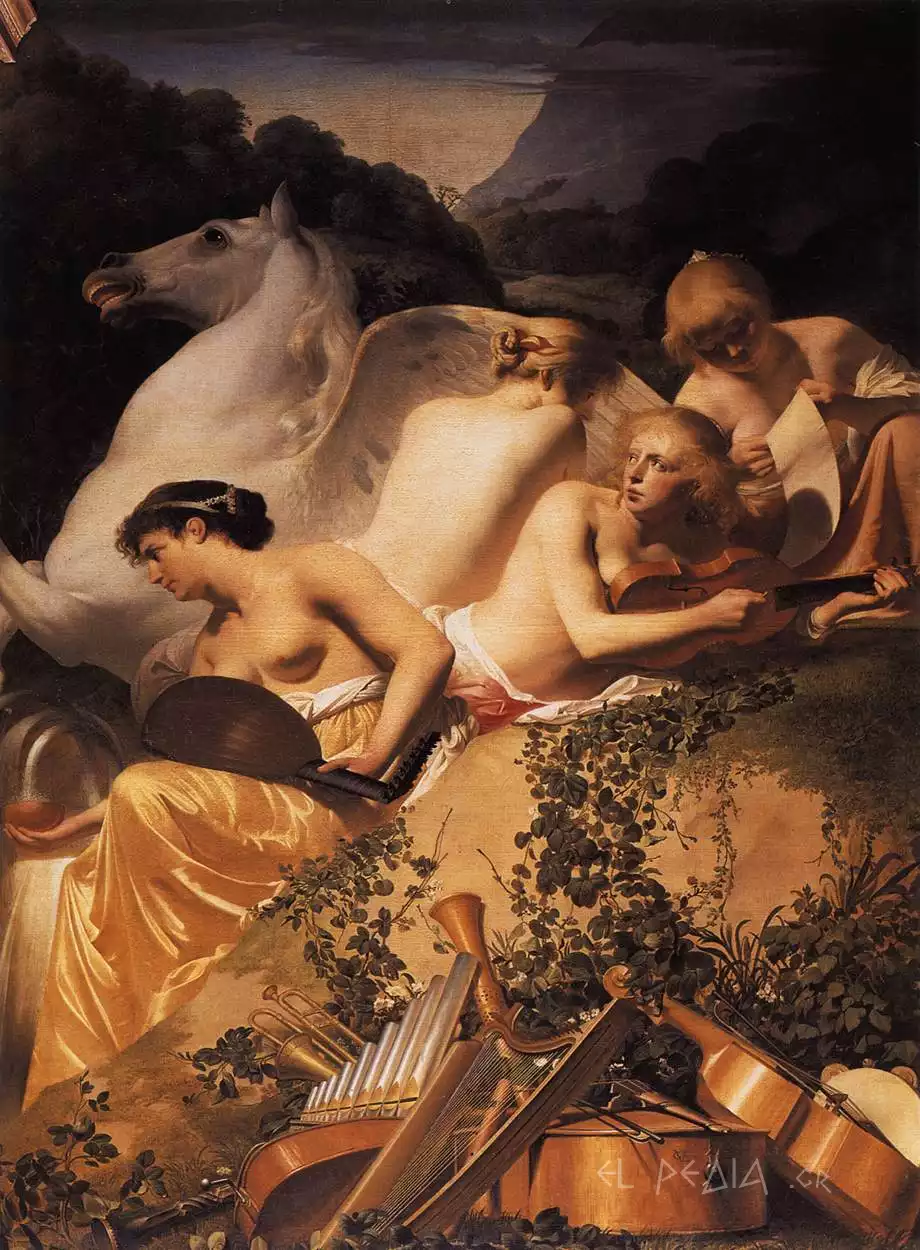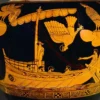
The Muses, the nine daughters of Zeus and Mnemosyne, are fundamental figures of ancient Greek mythology embodying artistic inspiration and intellectual creation. Their presence in ancient Greek culture is decisive, as they served as protectors of the arts and sciences, inspiring poets, musicians, dancers, and philosophers. They resided on Olympus, where with their melodious voices they delighted the gods, while they were often associated with places like Helicon and Parnassus.
Each Muse had her own distinct sphere of influence: Calliope protected epic poetry, Clio history, Erato love poetry, Thalia comedy, Melpomene tragedy, Terpsichore dance, Euterpe lyric poetry, Polyhymnia sacred poetry, and Urania astronomy. Their significance in ancient Greek thought is reflected in the practice of poets invoking their help at the beginning of their works, a tradition that began with Homer and continued for centuries.
The ancient Greeks believed that the Muses were not merely allegorical figures, but living deities who could directly influence human creativity. Their impact on art and culture was so decisive that the word “music” derives from their name, while the term “museum” originally referred to a place dedicated to their worship.
The myth of the birth and origin of the Muses
The birth of the Muses is inextricably linked to the cosmogonic period of ancient Greek mythology. According to the prevailing version, the Muses were born in Pieria, Macedonia, after nine consecutive nights of union between Zeus and Mnemosyne, the goddess of memory. The symbolic significance of this union is profound, as it represents the conjunction of power and knowledge, the celestial and the chthonic element.
The presence of the Muses in ancient Greek thought was decisive for the shaping of spiritual life. Initially, the musical deities were worshipped in various regions of Greece, with different numbers and names, before the canonical number of nine Muses was established (Barker). The evolution of their worship reflects the gradual formation and systematization of Greek mythology and religion.
In ancient Greek tradition, the Muses possessed exceptional musical and dancing abilities, and their voices were considered divine and enchanting. Their presence at the gatherings of the gods on Olympus was an integral part of the celebrations, where they sang about the achievements of the gods and heroes, accompanied by Apollo’s lyre. Their relationship with Apollo, the god of music and poetry, was particularly close, as he led their dance and was considered their protector.
The role of the Muses as bearers of divine inspiration and knowledge is reflected in the numerous myths related to the punishment of those who dared to challenge them in art competitions. A characteristic example is the case of the Pierides, the nine daughters of the king of Macedonia, Pierus, who were transformed into birds when they dared to compete with the Muses in singing. These stories emphasize the importance of humility in the face of divine inspiration and the wisdom that the Muses represented.
Ancient writers and artists often invoked the help of the Muses at the beginning of their works, a tradition that began with Homer and continued until the end of antiquity. This invocation was not merely a literary device but reflected a deep belief in the divine origin of artistic inspiration and knowledge.
The nine Muses and their characteristics
The unique nature and characteristics of the nine Muses are the subject of detailed study in ancient Greek literature. Each Muse, endowed with unique qualities, played a specific role in intellectual and artistic creation. The distinction of their responsibilities reflects the complexity and breadth of human intellectual activity.
Calliope, the eldest and most important of the Muses, oversaw epic poetry and the art of rhetoric. Her name, meaning “she who has a beautiful voice,” indicates the inseparable connection between oral tradition and epic storytelling in ancient Greek culture. In ancient mythical tradition, her special relationship with epic poets, whom she inspired and guided in the composition of their works, is evident (Murray).
Each Muse had specific symbols and characteristics that made her recognizable in art and literature. Clio, the protector of history, was usually depicted with a scroll and stylus, symbols of historical recording and the preservation of collective memory, while Melpomene, the Muse of tragedy, bore a tragic mask and cothurni, the characteristic footwear of tragic actors.
Euterpe, whose name means “she who delights,” was under the protection of lyric poetry and the music of the aulos, while Terpsichore, “she who delights in dance,” oversaw the art of dance and choral poetry. Thalia, the Muse of comedy and cheerful poetry, symbolized the joy of life and cheerfulness, bearing the comic mask. Erato, the protector of love poetry, was associated with hymns to love, while Polyhymnia oversaw sacred hymns and the art of mime. Finally, Urania, the Muse of astronomy, symbolized the human effort to understand celestial phenomena.
The symbolic significance of the Muses transcends the simple personification of the arts. They represent the multifaceted nature of human creativity and the eternal quest for knowledge and artistic expression. Their presence in ancient Greek thought underscores the deep belief that artistic creation and intellectual pursuit are divine gifts that require respect and dedication.

The worship of the Muses in ancient Greece
The worship of the Muses in ancient Greece is a complex religious and cultural phenomenon that decisively shaped the spiritual life of the ancient world. Archaeological findings testify to the existence of organized worship centers, with the most significant being those of Helicon in Boeotia and Pieria in Macedonia, where devotees came to honor the deities of intellectual creation.
In the sanctuaries of the Muses, special rituals and competitions of music and poetry were held. The poetic inspiration was considered a divine gift transmitted to mortals through their contact with the Muses (Bassett). The musical and poetic competitions, regularly organized in their honor, were significant cultural events where artists from various regions of the Greek world showcased their talent under the auspices of the divine patrons of the arts.
The architectural layout of the sacred spaces reflected the importance the ancient Greeks attributed to the worship of the Muses, with the construction of temples, altars, and special spaces for artistic events. In Helicon, the most important center of worship for the Muses, there was an extensive sacred grove with temples and statues dedicated to the nine deities, while the springs and streams that crossed the area were considered sacred and believed to have the property of inspiring artists.
The spread of the worship of the Muses in the Greek world is closely linked to the development of education and the cultivation of letters and arts. The Museia, as the places of worship of the Muses were initially called, gradually evolved into centers of learning and intellectual cultivation. The famous Museum of Alexandria, founded by the Ptolemies, is a characteristic example of this evolution, as it functioned as the most important center of research and learning in the ancient world.
The influence of the worship of the Muses extended into the daily life of the ancient Greeks, with the establishment of festivals and ceremonies in their honor in various cities. The musical and poetic competitions held during these festivals were not only religious in nature but were significant social events that strengthened the bonds between the various Greek cities and promoted cultural development.
The legacy of the Muses in modern culture
The timeless influence of the Muses on intellectual and artistic creation extends far beyond the boundaries of antiquity, decisively shaping the evolution of Western culture. Their spiritual cultural heritage continues to inspire and guide contemporary artistic expression (Glickstein).
The concept of artistic inspiration, rooted in the ancient Greek perception of divine intervention by the Muses, gradually transformed into a more refined philosophical view of the creative process, while retaining the core of its original meaning. In the modern era, the reference to the Muses continues to symbolize the eternal quest for artistic perfection and the indissoluble relationship between inspiration and creation.
In the field of education and culture, the influence of the Muses is reflected in the organization and operation of modern museums, academic institutions, and cultural centers. The idea of the museum as a place of gathering, preservation, and study of human creation traces its origins to the ancient Museia, the sacred spaces dedicated to the worship of the nine deities of art and knowledge.
Contemporary literary and artistic production continues to draw inspiration from the forms and symbols of the Muses, highlighting their timeless significance as archetypes of human creativity. Their presence in modern art, whether as direct references or symbolic representations, testifies to their uninterrupted influence on artistic expression and intellectual pursuit.
The contribution of the Muses to the shaping of the modern perception of art and creation remains decisive, reminding us of the importance of inspiration and intellectual cultivation in human progress. Their legacy continues to enrich contemporary culture, offering a timeless framework for understanding and interpreting artistic creation.
The study of the presence of the Muses in the history of human culture reveals their timeless significance as symbols of intellectual and artistic creation. From antiquity to the modern era, the nine daughters of Zeus and Mnemosyne continue to inspire and guide human creativity.
The evolution of their worship from a religious phenomenon to a cultural symbol demonstrates the adaptability and timeless value of their symbolism. The modern reception of the Muses as archetypes of artistic inspiration is a testament to their uninterrupted influence on human thought and creation.
The legacy of the Muses remains alive in contemporary institutions of art and education, reminding us of the importance of intellectual cultivation and artistic expression in human evolution. Their enduring presence in our culture confirms the timeless need of humanity for inspiration and creative expression.
elpedia.gr
Bibliography
Bassett, Samuel E. “The Muse, the Poet and the Grammarian.” The Classical Weekly 18, no. 17 (1925): 129-130.
Devereux, George. “Thamyris and the Muses.” The American Journal of Philology 108, no. 2 (1987): 199-201.
Glickstein, Susan S. “The Nine Muses of Greek mythology: Their place and purpose in our lives today.” PhD diss., Union Institute, 1998.
Murray, Penelope. “The Mythology of the Muses.” In A Companion to Ancient Greek and Roman Music, edited by Timothy Power and Eleonora Rocconi, 17-30. Wiley Online Library, 2020.
Wilson, Peter. “Music and the Muses.” In Music in Ancient Greece and Rome, 296-297. Cambridge: Cambridge University Press, 2004.

